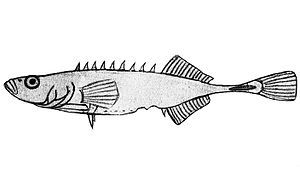Pungitius sinensis
| Pungitius sinensis | ||||||||||||
|---|---|---|---|---|---|---|---|---|---|---|---|---|

Pungitius sinensis |
||||||||||||
| Systematics | ||||||||||||
|
||||||||||||
| Scientific name | ||||||||||||
| Pungitius sinensis | ||||||||||||
| ( Guichenot , 1869) |
Pungitius sinensis is a fish that predominantly lives in small waters, which is found in coastal fresh waters in the Russian region of Primorye , in western Kamchatka , on the Russian island of Sakhalin , on the Kuriles , on thenorthernJapanese island of Hokkaidō , in northern Honshu , in North Korea and in the northeast of South Korea occurs.
features
Pungitius sinensis has a slender body, becomes 6.5 cm long and is similar in color to the nine-spined stickleback . There are six to eight enlarged scales on the sides of the body. Usually Pungitius sinensis has eight to eleven dorsal spines. The dorsal fin is supported by eight to twelve soft rays. The number of gill rakes is 10 to 14. In addition to one pelvic spine , there are also two associated soft rays on each side of the body. The caudal fin is usually rounded. Of the 33 to 35 vertebrae in the species, 14 to 15 are precaudal vertebrae.
distribution and habitat
Pungitius sinensis lives in very small bodies of water. Like all sticklebacks, it builds a nest of plant material just above the bottom of the water during spawning time and shows pronounced, sometimes very complex brood care behavior.
literature
- Yazdan Keivany & Joseph S. Nelson (2000): Taxonomic review of the genus Pungitius (Gasterosteidae). Cybium v. 24 (no. 2): 107-122.
- Hiroshi Takahashi, Peter R. Møller, Sergei V. Shedko, Temirbekov Ramatulla, Sang-Rin Joen, Chun-Guang Zhang, Valentina G. Sideleva, Keisuke Takata, Harumi Sakai, Akira Gotoi, Mutsumi Nishida: Species phylogeny and diversification process of Northeast Asian Pungitius revealed by AFLP and mtDNA markers. Molecular Phylogenetics and Evolution, 2016, doi: 10.1016 / j.ympev.2016.03.022
Web links
- Pungitius sinensis on Fishbase.org (English)
- Pungitius sinensis in the endangered Red List species the IUCN 2015 Posted by: Martin, J. & Wiswedel, S., 2013. Accessed March 27, 2016th